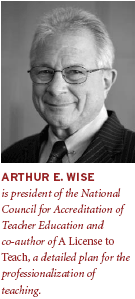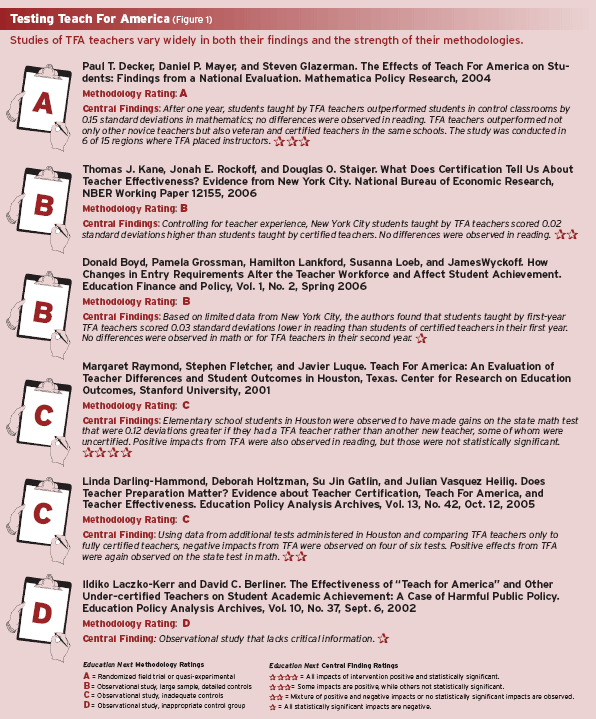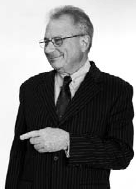 Schools across the nation are confronting the challenge to place an effective teacher in every classroom. In the provisions of No Child Left Behind, alternative licensure programs, and teacher pay plans, education reformers seek ways to improve the quality of the nation’s teaching workforce. One landmark effort to tackle this issue is Teach For America (TFA). The initiative famously launched by 22-year-old Wendy Kopp and a small cadre of allies in 1990 has brought thousands of talented young people into teaching. In this forum, Education Next asks Julie Mikuta and Arthur Wise whether Teach For America is a valuable strategy for recruiting the best and brightest into education and energizing school improvement, or a distraction and a device for sending ill-prepared neophytes to serve some of the nation’s neediest students.
Schools across the nation are confronting the challenge to place an effective teacher in every classroom. In the provisions of No Child Left Behind, alternative licensure programs, and teacher pay plans, education reformers seek ways to improve the quality of the nation’s teaching workforce. One landmark effort to tackle this issue is Teach For America (TFA). The initiative famously launched by 22-year-old Wendy Kopp and a small cadre of allies in 1990 has brought thousands of talented young people into teaching. In this forum, Education Next asks Julie Mikuta and Arthur Wise whether Teach For America is a valuable strategy for recruiting the best and brightest into education and energizing school improvement, or a distraction and a device for sending ill-prepared neophytes to serve some of the nation’s neediest students.
EDUCATION NEXT: Has Teach For America (TFA) improved the caliber of candidates entering the teaching workforce or has it undermined teacher professionalism?
ARTHUR WISE: Founder Wendy Kopp’s call to public service has resonated with a generation of graduates of the nation’s leading universities. She has designed and implemented a program that 1) attracts additional talented young adults to serve some of our lowest-performing schoolchildren, 2) places them in hard-to-staff schools with two-year commitments, 3) prepares them for this daunting task with a five-week summer institute, and 4) plays some role in their induction. TFAers are a potentially valuable resource to our schools.
Whether TFA has in fact “improved the caliber of candidates,” however, depends on the criterion used to make the judgment. TFA was designed to help solve the “teacher shortage” in “under-resourced” urban and rural schools and should be measured against this objective.
Most well-off suburban school districts, and even urban schools serving privileged students, generally manage to attract and retain the teachers they need. With few exceptions (e.g., STEM [science, engineering, and mathematics] fields and special education), these districts hire only career-oriented, fully certified teachers, do not face annual challenges in finding replacements, and do not turn to TFA.
High-needs urban and rural schools, on the other hand, offer their teachers extremely challenging students, unusually poor working conditions, and compensation unresponsive to market conditions even within the teaching profession. At-risk children in these schools are taught year after year by a passing parade of neophytes with varying degrees of preparation. The absence of accomplished veterans to guide beginners exacerbates the challenge: Students enter school behind their peers. Their teachers have not yet learned to be effective. Although TFA corps members do perform a short-term public service by filling vacancies in hard-to-staff schools, they deflect attention from the lack of trained and experienced teachers who should be filling those seats. The problem of underresourced and underserved public schools serving the underperforming students is a continuing national tragedy, thus far unsolved by local, state, or national initiatives.
Professions normally have common programs of preparation and extended terms of practice. TFA does not fit the professional model of teaching; other professions do not assign novices primary responsibility.

 JULIE MIKUTA: One way to measure whether TFA has improved the caliber of teaching candidates is to take a close look at TFA’s own applicant pool. Traditionally, education majors have had some of the lowest SAT and GRE (Graduate Record Examination) scores, while the most-accomplished college students opted for careers in medicine, law, finance, or technology. TFA’s reputation for quality and selectivity has reversed this equation by creating a mindset on college campuses that teaching in a high-needs school is a highly desirable postcollege job. Roughly 10 percent of graduating seniors at Duke University and the University of Chicago applied to TFA last fall, as well as 11 percent of those at Spelman College, an historically black liberal arts college. The average grade-point average of the 2,900 TFA accepted corps members was 3.6; their average SAT score was above 1300. Nearly all held leadership positions on campus. As Negar Azimi pointed out in the New York Times (September 30, 2007), “Doing good has rarely been this hip—or this competitive.”
JULIE MIKUTA: One way to measure whether TFA has improved the caliber of teaching candidates is to take a close look at TFA’s own applicant pool. Traditionally, education majors have had some of the lowest SAT and GRE (Graduate Record Examination) scores, while the most-accomplished college students opted for careers in medicine, law, finance, or technology. TFA’s reputation for quality and selectivity has reversed this equation by creating a mindset on college campuses that teaching in a high-needs school is a highly desirable postcollege job. Roughly 10 percent of graduating seniors at Duke University and the University of Chicago applied to TFA last fall, as well as 11 percent of those at Spelman College, an historically black liberal arts college. The average grade-point average of the 2,900 TFA accepted corps members was 3.6; their average SAT score was above 1300. Nearly all held leadership positions on campus. As Negar Azimi pointed out in the New York Times (September 30, 2007), “Doing good has rarely been this hip—or this competitive.”
In general, the traits that TFA considers—including academic performance, verbal ability, and strong records of early leadership—line up with the traits found to correlate with teachers’ success. However, it has proved frustratingly difficult to compare teachers’ actual effectiveness in the classroom, because as a field, we too often rely on proxies like certification and tenure instead of on data that quantify teachers’ impact on student achievement.
To address this challenge, TFA relentlessly collects, analyzes, and uses data about the performance of the students in the classes taught by individuals trained through the program and has found that many of their teachers help students achieve at least a year’s worth of growth every year.
EN: Studies have shown that most TFA teachers leave the classroom after two to three years. Is that too short a time to have an impact in TFA’s targeted, troubled districts?
AW: Although many recruits with TFAers’ university backgrounds have great potential as teachers, few of them stay in teaching long enough to realize any advantage from those backgrounds. TFA recruits are a different “brand” of recruit from those who have invested time and money to prepare for a career of teaching. They seem to view their time in the classroom as community service; studies by Boyd and Grossman and by Kane and Rockoff have found that more than 80 percent are gone after three years.
The introduction of TFA recruits to teaching is not easy. As a September 2007 Washingtonian article on the new D.C. superintendent of schools Michelle Rhee (a TFA alumna) summarizes, “her first year of teaching was a disaster…. ‘I did not do right by the kids…. It was rough going.’ She says she couldn’t control the classroom; she spent her time disciplining, not teaching; she finished the year demoralized.”
Of course, every experienced teacher was once a novice, so not every student can have an experienced instructor. But there is almost universal agreement on the value of teacher experience, and research indicates a multiplier effect on students’ performance when they are taught by ineffective teachers over multiyear periods.
JM: Any measure of TFA teachers’ impact must begin with the environments in which they work. The 26 regions into which TFA places corps members include rural communities that struggle to lure enough teachers and urban neighborhoods that often lose their strongest teachers to the surrounding suburbs. This is the gap that TFA corps members step into. When I taught high school science as a TFA corps member in New Orleans, the science classroom next to mine was staffed midyear with a former band instructor because the school could not find a qualified science teacher to take the job.
Still, the question of how much impact any teacher can have in just two to three years is valid, especially given the research indicating that the largest growth in teacher effectiveness occurs during the first three years of teaching. But the first few years in the classroom can be ones of major impact. Yes, Michelle Rhee acknowledged that the eight-year-olds she taught in her first year “ran right over” her. However, as reported by the New York Times, by the end of her second year, students who had scored in the 13th percentile soared to grade level, with some students scoring in the 90th percentile. Rhee isn’t unique: TFA recruits many individuals who are able to figure out how to make those two years matter greatly to the students they teach, and equips them to help their students succeed academically.
EN: Is there any compelling evidence that TFA teachers are more or less effective than traditionally certified teachers (see Figure 1)?
JM: External research has validated TFA’s findings on teacher effectiveness: a June 2004 study by Mathematica Policy Research found that TFA teachers perform at least as well as traditionally prepared and certified teachers in similar schools, while a 2006 study published in Education Next (see Kane, Rockoff, and Staiger, “Photo Finish,” research, Winter 2007) found the same to be true in New York City.
The Mathematica Policy Research study of the effectiveness of TFA teachers was very sophisticated. Mathematica worked across six different high-poverty areas (ranging from the rural Mississippi Delta to urban Chicago) to randomly assign almost 2,000 students to 100 TFA and non-TFA classrooms. They then used common pre- and post-tests to get apples-to-apples results across these classrooms and geographies. The study found that students with TFA teachers attained greater gains in math and equal gains in reading compared with students of other teachers in the study, even those with certified teachers and with veteran teachers.
The impact on student achievement is the most important metric, but it is also instructive to consider the opinions of TFA corps members’ employers, who observe their practices day to day. Each year, TFA contracts with an external researcher to survey these principals, and year after year the majority of principals rate TFA teachers’ preparation and performance as at least as effective as that of other beginning teachers, and in many cases as even better than the overall teaching faculty. Additionally, some of the highest-achieving charter schools, like Achievement First, choose to staff their schools with TFA corps members. While these data are certainly subjective, they are yet another indicator that TFA has built a track record of preparing successful teachers.
AW: At least five studies include data on TFA. The 2004 Mathematica study says that “TFA teachers did not have an impact on average reading achievement. Students in TFA and control classrooms experienced the same growth rate in reading achievement—an increase equivalent to one percentile” [from the 14th to the 15th percentile]. In addition, many of the TFA teachers were actually more prepared than over half in the novice control group: “All TFA teachers had at least 4 weeks of student teaching, while many of the control teachers (and over half the novice control teachers) had no student teaching experience at all.” The abysmally low percentage of students at the proficiency level in both reading and math in this study demonstrates the results of the current policy of having inexperienced, untrained recruits teaching the most-needy students.
As a group, the studies tend to show that the students of uncertified TFA recruits underachieve when compared to students of new certified teachers, but this gap tends to disappear as the TFA recruits obtain professional knowledge through coursework and certification. Like similar studies in other areas of educational controversy, however, these results are indicative but not uniformly regarded as conclusive.
Whatever the relative performance of the two groups of new teachers, I know of no school or district that has made a conscious choice to hire TFA recruits instead of certified teachers. And the districts do not retain any substantial number of them long enough for the recruits to catch up to their peers. TFA recruits are placeholders in troubled schools where an adult must staff the classroom and no one else volunteers. They are hired because of the lack of certified applicants, not because they are considered more desirable.

EN: If TFA-like programs are going to improve teacher quality across the board, how should they be designed?
JM: When I was on the board of education for the D.C. public schools, I asked the person in charge of teacher induction how she determined which of the district’s teachers had been successful during their first year of teaching. She looked at me, somewhat incredulously, and said, “I ask them if they had a good year.” Her answer felt like a punch in the gut. Could it really be that the only way the district was assessing the quality of its teachers was to ask them if they liked the teaching experience? Is it possible that the experience of students didn’t factor at all into this assessment? Reflecting back on that moment, I can say with sad certainty that this response wasn’t unique to this individual or that district.
Every year colleges of education train thousands of teachers and send them into classrooms with very little understanding of whether that training was effective and what sort of achievement results these teachers will produce. Students would be much better off if policymakers and education leaders were to focus on student achievement results as a way to assess teacher quality overall, and to assess the quality of teacher preparation programs supported by federal and state dollars. TFA evaluates corps members’ performance by determining which teachers produced student gains of 1.5 years of achievement growth over the course of the school year. TFA has had to figure out how to assess teachers’ performance in subjects and grades that aren’t tested and how to compare results across state lines, where the quality and rigor of tests vary dramatically. At the heart of this effort is a focus on producing “significant gains” in student achievement and creating support systems aligned with that goal. This model marks a huge development in teacher assessment and support strategies.
TFA also regularly mines its data to figure out how it can select the individuals most likely to produce that sought-after 1.5 years of growth per year and how to tailor its training to best support teachers toward that end. TFA spends approximately $19,000 per corps member for training and ongoing support and development. This covers a rigorous five-week summer training institute with opportunities for practice, observation, coaching, and study, as well as support on planning skills and reflection toward a cycle of continuous improvement; a two-year program of teacher support and professional development, including a formal cycle of observations and feedback, and data-driven, student-achievement-focused tool kits; and help with placement and ongoing coaching over the two years from regional staff.
School districts hire TFA corps members through state-approved alternative certification programs, which require that corps members meet specific requirements. These vary by region and by position, but in most cases they call for corps members to pass subject-area tests before teaching and to take ongoing coursework during the school year. Teach For America works with school districts, states, and schools of education to ensure that corps members have access to coursework, test information, and preparation tools to meet these requirements. In many regions, TFA has established partnerships with graduate schools that enable corps members to obtain their master’s degrees in education.
AW: The sad reality is that our hard-to-staff schools will continue to have a disproportionate number of new teachers until we stop the hemorrhaging of their staff. We need a sharp break with tradition. Even certified teachers who have completed education-school coursework and student teaching need a structured induction program in order to become effective teachers. The need for training and supervision is even greater for recruits entering the field without any prior pedagogical training or experience, no matter how smart, dedicated, or steeped in subject-matter knowledge they may be. To be effective, all prospective teachers need a deep understanding of the subject matter, child development, and language development and sophisticated strategies for teaching content to diverse learners, managing the classroom, and assessing both how children learn and what they are learning.
I recommend a “teaching team strategy,” that gives only experienced teachers primary student responsibility, but in multiple classrooms and with the assistance of the novices. Senior teachers, appropriately compensated, lead instructional teams of other teachers, novices, and untrained personnel.
Since this very radical reform is unlikely to occur in the near future, we must for now at least insist that TFA recruits not only attend an intensive preservice summer institute but also receive structured mentoring that is uniformly as good in practice as on paper. They should be required to work toward certification while they are in the classroom.
In an ideal world, all new teachers would receive their capstone preparation and induction in a professional development school or an urban residency program. The National Council for Accreditation of Teacher Education (NCATE) has worked to improve professional development schools, which provide preparation and teaching experience. Three hundred of NCATE’s 650 accredited schools of education have a total of 750 professional development schools, each training 15 to 40 individuals each year. Studies published by NCATE (Teitel 2004) and by the American Educational Research Association (Cochran-Smith and Zeichner 2005) indicate that structured student teaching and internships in professional development schools increase the likelihood that novices remain in teaching, even in urban schools, and improve the performance of their students.
Recently, NCATE has begun working with urban residency programs, which pursue a similar strategy for those who have not been prepared as teachers. Existing programs include the Academy for Urban School Leadership in Chicago (training 53 this year), the Boettcher Teachers Program in Denver (16), and the Boston Teacher Residency, which currently (2007–08) has 84 participants and plans to have 100 to 120 candidates next year. One-half of Boston candidates are people of color; one-half of the candidates are in shortage fields of math and science.
Professional development schools currently provide more new teachers than TFA does each year, and urban residency programs are growing rapidly. These schools and programs should be receiving the lion’s share of policy attention, but unfortunately neither has a charismatic leader such as Wendy Kopp. These programs are not yet brought to scale, with the exception of Maryland, which requires all of its candidates to be trained in a professional development school. Other states could follow Maryland’s example. We hope they do.
An intermediate step could be the New York City Teaching Fellows program. Although this program does assign uncertified recruits as teachers of record, it also requires them to enroll concurrently in a master’s degree program focusing on teaching and learning.
TFA currently invests approximately $20,000 per recruit for a two-year teaching commitment. If the same amount were invested as a full stipend for a one-year Master of Arts in teaching program at a state university, America could reap more benefits over a longer period of time.
EN: Many TFA supporters point to the spinoffs launched by TFA alums, including The New Teacher Project (TNTP), the Knowledge Is Power Program (KIPP), and YES Prep and argue that many of those who initially entered education through TFA have gone on to become influential change agents. How convincing is the evidence for this?

JM: If TFA did not exist, it is highly doubtful that the 2005 National Teacher of the Year Jason Kamras, who taught for nine years in the Washington, D.C., public school system, would have become a teacher. The same goes for Mike Feinberg and Dave Levin, who went on to create KIPP based on principles for effective schooling that they first developed while they were TFA corps members. Today, KIPP’s schools catapult low-income students from the 30th percentile in math to the 70th or 80th, positioning them for success in high school and beyond. Because of TFA, KIPP schools are delivering an incredible education to more than 14,000 low-income students of color during this school year alone, and many of these students are being taught directly by current TFA corps members or alumni.
Add to the mix the impact of alumni like Mikara Solomon, who as principal of Bunche Elementary School in Compton, a very low income community in Los Angeles, led its transformation from one of the district’s lowest-ranked schools to one of the best performers, and the long-term impact of TFA alumni on students in low-income communities begins to emerge. TFA estimates that more than 280 of its alumni lead district or charter schools. At least 67 percent of alums continue to work or study full-time in education; half of these alumni are teachers.
TFA has also had an impact on district practices, much of which comes through the work of its alumni. The current administration of the D.C. Public Schools is staffed at the highest levels by TFA alumni who have remained committed to public education. The New Teacher Project has partnered with over 200 school districts in 32 states to recruit and prepare 23,000 teachers. Many of TNTP’s staff are TFA alumni as well; they sit side by side with human resources personnel to help fix broken recruiting and hiring systems that prevent the neediest schools from getting the best candidates. TFA alumnus Cami Anderson is superintendent of New York City’s district of Alternative Schools and Programs, where she oversees the educational needs of 50,000 young people at a variety of facilities, including transfer schools and correctional education facilities. In nearby New Jersey, alumnus Brian Osborne is the superintendent of the 6,000-student Maplewood-South Orange school district. And in Chicago, Michael Lach wields significant influence on district policy as director of science for Chicago Public Schools.
While I was head of alumni for TFA, each year about 90 percent of alumni indicated in an annual survey that they work, volunteer, or pursue graduate studies in fields that directly affect low-income communities. Whether they work inside or outside a school system, they bring a passion and sense of outrage that come from having spent at least two years learning about the challenges that low-income students and schools face.
 AW: These talented graduates, most from fortunate backgrounds, complete their TFA commitments with direct experience trying to help the nation’s less fortunate population learn and then they move on. Small minorities have remained in education (it appears mostly in policy positions) and have a direct opportunity to make a difference in the status quo. Michelle Rhee, for example, first used her TFA experience to develop The New Teacher Project in a parallel attempt to increase teacher quality in urban areas by recruiting new types of teachers, and now to help improve one of the nation’s worst-performing urban districts.
AW: These talented graduates, most from fortunate backgrounds, complete their TFA commitments with direct experience trying to help the nation’s less fortunate population learn and then they move on. Small minorities have remained in education (it appears mostly in policy positions) and have a direct opportunity to make a difference in the status quo. Michelle Rhee, for example, first used her TFA experience to develop The New Teacher Project in a parallel attempt to increase teacher quality in urban areas by recruiting new types of teachers, and now to help improve one of the nation’s worst-performing urban districts.
Some TFA graduates are already becoming part of the next generation of society’s leaders, and many more will surely follow. They have directly experienced the teacher quality conundrum in hard-to-staff schools, and they will presumably be willing to advocate for new approaches to ameliorate the problems of underresourced schools and underserved children.
EN: How many teachers would TFA need to prepare every year for the program to have a significant, even transformative, effect on urban education?
AW: Six hundred fifty NCATE-accredited schools graduate over 100,000 career-oriented teaching candidates a year (about two-thirds of the total graduates of university-based teacher education programs). TFA hopes to provide 4,000 teachers a year—for two-year stints—by 2010. Even if it continues to concentrate its efforts on hard-to-staff urban schools, any significant systemic impact must necessarily be catalytic rather than proportional.
JM: The program was never intended to solve the teacher shortage problem or even to fix public education simply by preparing bright college students to teach for two years. Instead, TFA intends to transform public education by exposing these talented people to the challenges of public education and engaging them in figuring out solutions, and by concentrating its impact within certain markets. Nearly 45 percent of TFA’s 12,000 alumni live in six regions—NYC, Chicago, Washington, DC, Los Angeles, the Bay Area, and Houston. As TFA grows, the organization’s impact will increase, as these alumni take on more visible and influential roles.
EN: Ultimately, what would you say is the single biggest impact—positive or negative—that TFA has had on American schooling?
AW: Given its small size TFA’s greatest positive impact may be the creation of a new generation of education and societal leaders with abiding interest and direct experience in the problems of educating our nation’s disadvantaged. The nation needs their help.
Government must invest in and redesign underresourced urban and rural schools so that they consistently provide high-quality education for their students. Eliminating the teacher shortage in hard-to-staff schools will require changing economic incentives, working conditions, and staffing patterns so that these schools attract and retain a competent teaching force that will help all students learn.
Teachers’ propensity to remain in a school depends heavily on their perception of teaching conditions and the degree to which they see the school environment supporting their teaching. Efforts to redesign hard-to-staff schools to provide attractive teaching conditions have been insufficient and inadequate.
Still I do not think any of us presumes to think that teachers will remain in positions as long as their predecessors did when many other types of occupations and professions were not open to women or people of color. There must be economic incentives, both relative to other professions and within the education profession, for career-oriented teachers to teach those students who most need their abilities and experience.
JM: There is no doubt that Teach For America has had a positive impact on American education. This impact has played out along two primary dimensions. First, the teachers it recruits are in fact good teachers who produce achievement gains for students that match or exceed those accomplished by other new teachers who have been prepared in other ways. Second, TFA has channeled thousands of talented people into education who might not otherwise have chosen this profession, and shown them what it takes to educate high-need students. Although TFA is by no means the entire solution to the problems facing public education, or even our teacher shortage, TFA is helping to redefine the educational and economic opportunities available in rural and urban communities.
Teach For America, by focusing all of its teachers on the singular goal of helping their students make more than one year’s worth of growth in a single year, is proving that we have no excuse for the perennial underachievement of children from low-income communities. As corps members and as alumni, TFA teachers carry this torch into their careers in education, public service, and other sectors, lighting a fire under our public will that can ignite much-needed change in public education. Their work will augment the efforts of many others who are simultaneously working at all levels and in a variety of fields to make high-quality education the norm, regardless of the school a child attends.


